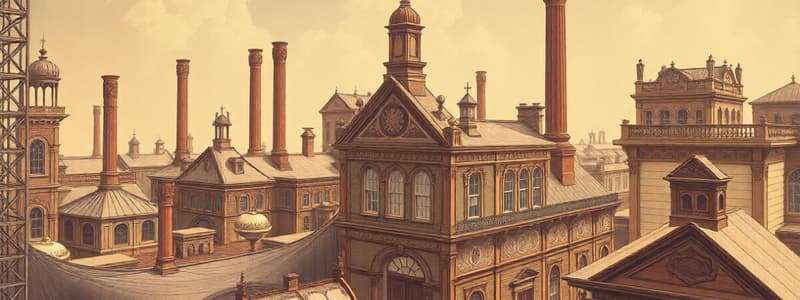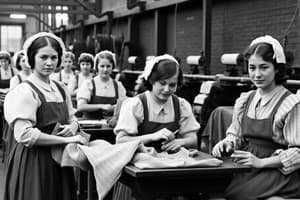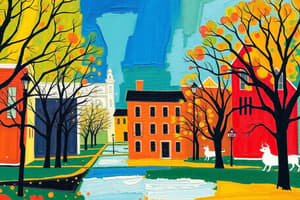Podcast
Questions and Answers
Which factor most contributed to the initial deterioration of working conditions for women in the Lowell mills?
Which factor most contributed to the initial deterioration of working conditions for women in the Lowell mills?
- Mandatory church attendance and strict curfews.
- The prioritization of profits over worker well-being. (correct)
- The implementation of new textile machines requiring less skill.
- The replacement of American workers with Irish immigrants.
What was a key difference between the Waltham system and later labor practices in the Lowell mills?
What was a key difference between the Waltham system and later labor practices in the Lowell mills?
- The Waltham system primarily employed entire families, while later practices focused on individual workers.
- The Waltham system integrated the entire weaving process under one roof, while later systems divided labor into specialized tasks.
- The Waltham system recruited unmarried young women, while later practices increasingly hired immigrants at lower wages. (correct)
- The Waltham system was characterized by better working conditions and wages compared to later practices.
What was a significant consequence of industrialization on urban environments in the early 19th century?
What was a significant consequence of industrialization on urban environments in the early 19th century?
- Significant air and water pollution from steam and coal-burning engines. (correct)
- Decreased urban populations due to factory work being undesirable.
- Reduced social stratification as factory jobs provided equal opportunities for all.
- Improved public health and sanitation due to increased resources.
How did the completion of the Erie Canal impact New York City's growth?
How did the completion of the Erie Canal impact New York City's growth?
How did urban entertainment options differ for men and women in the early 19th century?
How did urban entertainment options differ for men and women in the early 19th century?
What role did Stephen Foster's songs play in shaping perceptions of slavery?
What role did Stephen Foster's songs play in shaping perceptions of slavery?
What was a primary cause of the surge in immigration to the United States in the mid-19th century?
What was a primary cause of the surge in immigration to the United States in the mid-19th century?
How did the experiences of German immigrants differ from those of Irish immigrants in the United States?
How did the experiences of German immigrants differ from those of Irish immigrants in the United States?
What was the main goal of nativist movements in the United States during the mid-19th century?
What was the main goal of nativist movements in the United States during the mid-19th century?
What factor contributed to anti-Irish sentiment in the United States?
What factor contributed to anti-Irish sentiment in the United States?
What was a key objective of the early labor organizations in the United States?
What was a key objective of the early labor organizations in the United States?
What was the significance of the Commonwealth v. Hunt Supreme Court case?
What was the significance of the Commonwealth v. Hunt Supreme Court case?
How did Horace Mann contribute to education reform in the United States?
How did Horace Mann contribute to education reform in the United States?
What role did McGuffey Readers play in American education during the 19th century?
What role did McGuffey Readers play in American education during the 19th century?
Which profession saw significant growth during the Industrial Revolution?
Which profession saw significant growth during the Industrial Revolution?
What was a significant challenge faced by women seeking careers in male-dominated professions in the 19th century?
What was a significant challenge faced by women seeking careers in male-dominated professions in the 19th century?
Which of the following factors contributed most significantly to the economic growth of New York City in the early 19th century?
Which of the following factors contributed most significantly to the economic growth of New York City in the early 19th century?
Which of the following best describes the impact of the Industrial Revolution on the physical landscape of New England?
Which of the following best describes the impact of the Industrial Revolution on the physical landscape of New England?
How did the influx of Irish immigrants affect labor dynamics in American cities?
How did the influx of Irish immigrants affect labor dynamics in American cities?
Which of the following describes a key characteristic of the 'cult of domesticity'?
Which of the following describes a key characteristic of the 'cult of domesticity'?
Which of the following statements accurately describes the experience of Chinese immigrants in the United States during the mid-19th century?
Which of the following statements accurately describes the experience of Chinese immigrants in the United States during the mid-19th century?
Which of the following factors played a significant role in the rise of nativism in the United States during the 19th century?
Which of the following factors played a significant role in the rise of nativism in the United States during the 19th century?
What was the primary goal of the Working Men's political parties that emerged in the early 19th century?
What was the primary goal of the Working Men's political parties that emerged in the early 19th century?
What was a core philosophy that was taught to children in school?
What was a core philosophy that was taught to children in school?
Which of the following was an achievement of Elizabeth Blackwell?
Which of the following was an achievement of Elizabeth Blackwell?
What determined Cincinnati's growth?
What determined Cincinnati's growth?
Which city grew as a result of shipping items from the Mississippi River?
Which city grew as a result of shipping items from the Mississippi River?
What allowed St. Louis for urban growth?
What allowed St. Louis for urban growth?
What was the most common type of sport?
What was the most common type of sport?
By how much did the urban and rural population increase?
By how much did the urban and rural population increase?
Why did the Germans immigrate to America?
Why did the Germans immigrate to America?
Why did the the Irish immigrate to the United States?
Why did the the Irish immigrate to the United States?
Which party formed as nativism expanded?
Which party formed as nativism expanded?
By how much did the American workers work for wages by 1860?
By how much did the American workers work for wages by 1860?
How much shorter was a shoe workers lifespan?
How much shorter was a shoe workers lifespan?
Where was Horace Mann from?
Where was Horace Mann from?
Which of the following could women specialize in?
Which of the following could women specialize in?
Flashcards
Rhode Island System
Rhode Island System
The recruitment of entire families, including children, as laborers in mills during the early 19th century industrialization.
Waltham System
Waltham System
The recruitment of unmarried young women for employment in factories, particularly in Lowell, Massachusetts, during the 19th century.
Lowell System
Lowell System
Putting the entire weaving process under one roof, powered by a nearby river.
Mill Workers (Lowell Girls)
Mill Workers (Lowell Girls)
Signup and view all the flashcards
Cult of Domesticity
Cult of Domesticity
Signup and view all the flashcards
Minstrel Shows
Minstrel Shows
Signup and view all the flashcards
Nativism
Nativism
Signup and view all the flashcards
Know-Nothing Party
Know-Nothing Party
Signup and view all the flashcards
Trade Union/Labor Union
Trade Union/Labor Union
Signup and view all the flashcards
Commonwealth v. Hunt (1842)
Commonwealth v. Hunt (1842)
Signup and view all the flashcards
Horace Mann
Horace Mann
Signup and view all the flashcards
Rise of Professions
Rise of Professions
Signup and view all the flashcards
Elizabeth Blackwell
Elizabeth Blackwell
Signup and view all the flashcards
Irish Potato Famine (1845-1849)
Irish Potato Famine (1845-1849)
Signup and view all the flashcards
Study Notes
- Focus on mills dominating the national marketplace.
Labor Systems in the Textile Industry
- Rhode Island System: Recruited entire families, including children, as laborers in mills.
- Mill work initially offered women independence and education, but conditions declined as profits became the priority.
- Waltham System: Recruited unmarried young women for factory employment, exemplified by mills in Lowell, Massachusetts.
- Massive factories required a large workforce, leading to the development of cities around the factories.
- Lowell System: Centralized the entire weaving process under one roof, powered by a nearby river
- Primarily employed young women aged 15-30, often selected for their textile machine skills.
- Paid $2.50 per week, lower than men for the same work, but still considered high wages for women at the time.
- Included mandatory church attendance, strict curfews, long hours, low wages, and dormitory living.
- Conflicts arose between native-born mill workers and owners.
- Mill owners increasingly hired Irish immigrants who accepted lower wages.
- Mills and factories transformed the New England landscape in the early 19th century.
- Textile mill, established during the Embargo of 1807 (Union Manufacturers), eventually employed over 600 people.
- Industrialization relied on steam and coal-burning engines, leading to soot and pollution.
Urban Growth in the 19th Century
- Urban population increased from 3% to 16% between 1790 and 1860.
- New York City surpassed all other cities, becoming the first to exceed one million people.
- Key factors in New York City's growth: natural harbor, access to the Erie Canal.
- Philadelphia, Baltimore, and Boston remained large due to their roles as Atlantic seaports.
- New Orleans, a key site for shipping via the Mississippi River, became the nation's fifth-largest city.
- In the early 1800s, the largest American cities were on the Atlantic coast.
- Inland port cities like St. Louis, Cincinnati, Cleveland, Detroit, and Chicago emerged as important urban centers by 1860.
- Great Lake ports: Buffalo, Cleveland, Milwaukee, Detroit, and Chicago.
- New industrial towns, e.g., Pittsburgh, experienced rapid growth.
- Pittsburgh functioned as an exchange center with a significant manufacturing sector.
- Cincinnati was known as "Porkopolis" for its early meatpacking industry.
- St. Louis was ideally located for urban growth due to its position on the Mississippi and Missouri Rivers.
Popular Culture and Entertainment
- Communal activities remained popular in rural areas.
- Blood sports (e.g., bare-knuckle boxing) were popular urban entertainment for men.
- Other popular sports included cockfighting and dogfighting
- Taverns and saloons became more common.
- Theaters were the primary outlet for American entertainment
- Respectable women seldom attended due to the Cult of Domesticity.
- Performing arts venues (theaters, opera houses, playhouses, music halls) primarily attracted male audiences.
- Minstrel shows, featuring white performers in blackface, were popular nationwide but reinforced racial stereotypes.
- Northern working-class and Southern whites particularly enjoyed minstrel shows.
- Composer Stephen Foster's popular songs perpetuated myths about contented slaves.
Immigration in the 19th Century
- European turmoil, including the Napoleonic Wars (ended in 1815) and the nationalist revolutions of 1848, led to a major influx of immigrants.
- Between 1845 and 1854, the U.S. experienced a significant proportional influx of immigrants
- Close to 3 million immigrants, about 15% of the total U.S. population in 1845.
- Irish and German immigrants were the largest groups between 1840 and 1860.
Irish Immigration
- The Irish Potato Famine emerged in 1845 due to a fungus that ruined potato crops.
- About 1 million people died, and almost 2 million Irish left their country (out of a population of 4 million).
- Many traveled to Canada and the United States.
- Majority of Irish immigrants were Roman Catholic, with an average age in their early 20s.
- The Irish came to comprise over half the population of Boston and New York City.
- Living conditions were poor, with most living in tenement apartment houses.
- Crime, disease, alcoholism, and prostitution were prevalent in Irish neighborhoods.
- Major cities saw the emergence of anti-Catholic and anti-Irish publications.
- Irish Americans often showed ill will towards other groups, such as free African Americans, due to competition for low-wage jobs.
German Immigration
- German immigrants tended to be better educated than the Irish.
- They often settled in the interior of the United States.
- German immigrants frequently traveled in families, preserving their language and culture.
- A greater number of German immigrants eventually returned to their country of origin.
- Prominent German immigrants: Heinrich Steinweg (Steinway) for musical instruments and Levi Strauss for work pants (Levi's).
- German immigrants established their own communities, maintaining native traditions such as beer halls.
Other Immigrant Groups
- Included British, Scandinavian, and Chinese immigrants.
- British immigrants included professionals, independent farmers, and skilled workers.
- By 1869, Scandinavians numbered over 70,000, settling farmlands in the Upper Mississippi River Valley (e.g., Minnesota).
- Chinese immigrants primarily went to California, numbering about 35,000 by 1860.
- Mostly male "birds of passage," aiming to earn money and return home.
- Faced discrimination, being excluded from jobs like mining and farming during recessions.
- Many Chinese immigrants worked as laundrymen.
- The Federal Naturalization Law of 1790 prevented them from becoming U.S. citizens.
Nativism
- The influx of Roman Catholic immigrants aroused fears among Protestant Americans.
- This led to a surge in nativism, favoring native-born inhabitants over immigrants.
- Anti-immigrant measures in the 1840s and 1850s were spearheaded by descendants of immigrants from Britain and Northern Europe.
- Displayed dislike for Irish Catholics, African Americans, and recent immigrants.
- Much of the bias against Irish immigrants was anti-Catholic in nature.
- The American Party (Know-Nothing Party) formed and spread, maintaining secrecy.
- Members agreed not to vote for Catholics or foreign-born candidates.
- Targeted immigrants and Catholics, aiming to prevent them from becoming citizens.
Organized Labor
- By 1860, 40% of American workers worked for wages (compared to 12% in 1800).
- This came at the expense of skilled self-employed artisans and craftsmen who struggled to compete with factories.
- Shoe shops were displaced by factories.
- In 1850, the Board of Health in Lynn, Massachusetts, reported that the life expectancy of a shoe worker was 20 years shorter than that of a farmer.
- Skilled workers responded by organizing into trade associations to address challenges.
- Labor organizations, in the form of trade unions, labor politics, and guilds, were created.
- Trade associations were the first type of labor unions.
- They advocated for protective tariffs.
- Faced legal obstacles.
- The National Trade Union formed in 1834 to organize local trade unions.
- Women formed trade unions, e.g., Sarah G. Bagley helped organize the New York Female Labor Reform Society.
- Advocated for laws to regulate banks, abolish imprisonment for debt, free public education supported by taxes, and a 10-hour workday.
- In 1806, Philadelphia shoemakers who went on strike were found guilty of conspiracy.
- Commonwealth v. Hunt (1846): The Massachusetts Supreme Court ruled that labor strikes were legal.
- Determined that trade unions were not necessarily subject to laws against criminal conspiracies.
Rise of Professions
- Before the 1820s, schooling in America was informal.
- The first political demands for free, tax-supported schools originated with the Working Men's Movement.
- Horace Mann championed education reform in Massachusetts and other Northern states.
- Stressed centralized state control over schools and uniform standards.
- Promoted free public education to train children for citizenship.
- Just over half of white children between 5 and 19 were enrolled in schools in 1850.
- School reform appealed to the Northern middle classes.
- Teaching was the fastest-growing of the new professions.
- McGuffey Readers promoted reading, writing, morals, and values.
- Aspiring lawyers apprenticed with established lawyers.
- Many self-styled physicians lacked formal training.
- The public distrusted the medical profession until the rise of formal medical schools.
- The Industrial Revolution spurred the development of engineering as a profession.
- By the Civil War, engineering had become one of the largest professions.
Women's Work
- Women were primarily considered caregivers in the home.
- More women sought careers in teaching and nursing.
- Midwifery also became an option.
- Religious and social service work were accessible to middle-class women.
- Elizabeth Blackwell was the first woman to receive a medical degree.
- Started at the New York Infirmary for Women and Children.
- First in her class
Studying That Suits You
Use AI to generate personalized quizzes and flashcards to suit your learning preferences.





